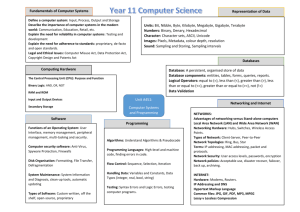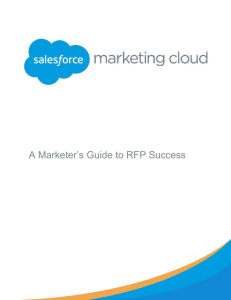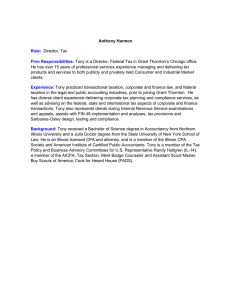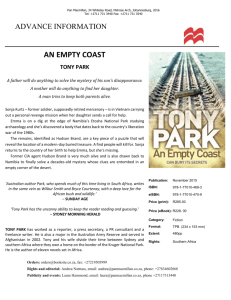Addressing Systemic Complexity with SOA and Cloud Tony Shan SOA Architect
advertisement
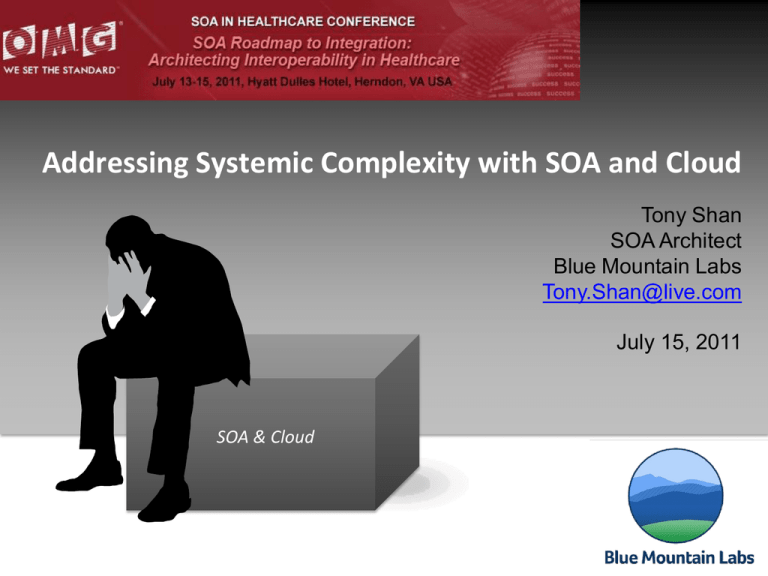
Addressing Systemic Complexity with SOA and Cloud Tony Shan SOA Architect Blue Mountain Labs Tony.Shan@live.com July 15, 2011 SOA & Cloud Contents at a Glance • • • • • • • • • • • • • • • Introduction What is SOA What is Cloud Why Combination Barriers to Successful SOA Barriers to Successful Cloud Reality Check State of Art of Complexity Management Need Pragmatic Method Increasing Disparate Representations Increasing Dynamics Increasing Fragmented Activities on Specifications Increasing Components Best Practices Wrap-up Addressing Systemic Complexity © 2011 Tony Shan. Proprietary and Confidential. 2 Introduction Addressing Systemic Complexity © 2011 Tony Shan. Proprietary and Confidential. 3 Concept of SOA The Open Group OASIS • Service-Oriented Architecture (SOA) is an architectural style that supports service orientation, which is a way of thinking in terms of services and service-based development and the outcomes of services. • SOA is a paradigm for organizing and utilizing distributed capabilities that may be under the control of different ownership domains. It provides a uniform means to offer, discover, interact with and use capabilities to produce desired effects consistent with measurable preconditions and expectations. Addressing Systemic Complexity © 2011 Tony Shan. Proprietary and Confidential. 4 Definition of Cloud Computing Cloud Computing is a model for enabling convenient, on-demand network access to a shared pool of configurable computing resources (e.g., networks, servers, storage, applications, and services) that can be rapidly provisioned and released with minimal management effort or service provider interaction. This cloud model promotes availability and is composed of five essential characteristics, three service models, and four deployment models. -- NIST Definition, V15 Addressing Systemic Complexity © 2011 Tony Shan. Proprietary and Confidential. 5 Why SOA+Cloud Combined? SOA Cloud • Service Orientation • Mostly software-intensive • Application integration • Service reuse via shared services • Predominantly used within the enterprise • XaaS • Mainly hardware-focused • Resource provisioning • Infrastructure pooling and outsourcing • New business model for service delivery and consumption Addressing Systemic Complexity © 2011 Tony Shan. Proprietary and Confidential. 6 Barriers to Successful SOA Initiatives solely led and driven by techies Home-grown reference models Product lock-in with no or limited interoperability Insufficient semantics in service composition Ad-hoc governance (dictatorship or anarchy) Inability to quantify ROI/TCO and improper-sizing Disconnection between traditional education and real-world SOA implementation needs Gap between logical architecture and infrastructure Project-centric execution without reuse/sharing disciplines Absence of holistic roadmaps with specificity Lack of well-defined service models (business and technical) Immature specifications and standardization Addressing Systemic Complexity © 2011 Tony Shan. Proprietary and Confidential. 7 Top 10 Cloud Adoption Inhibitors Risk-Testing •How is the cloud computing vendor managing risk? Vendor Viability •What will happen if the cloud computing vendor goes out of business? Data Location Data and Code Portability •Where is the data being stored? Incountry or out of the country? What restrictions and laws are placed upon the data dependent on location of stored data? •Once the data has been put onto the cloud computing system, how difficult will it be to get the data back out? Performance ROI •How can SLA guarantee performance? •Does operational expense always trump capital expense, at least in technology investment? Data Loss •Does the cloud computing system back-up and restore data? Security •What are the vulnerabilities in the Cloud architecture? Data Privacy •Does the data become more vulnerable when it is located on an external cloud computing system? Control •How can a cloud provider be trusted that they care about your IT processing as much as you do? Source: Adapted and extended from Gartner and InformationWeek reports in 2009 and 2010. Addressing Systemic Complexity © 2011 Tony Shan. Proprietary and Confidential. 8 What these lead to… Addressing Systemic Complexity © 2011 Tony Shan. Proprietary and Confidential. Page 1 of 2 9 How to Effectively Deal with Complexity? Addressing Systemic Complexity © 2011 Tony Shan. Proprietary and Confidential. 10 State of Art Source: Wikipedia Addressing Systemic Complexity © 2011 Tony Shan. Proprietary and Confidential. 11 In Search for a Pragmatic Approach We can't solve problems by using the same kind of thinking we used when we created them. [Albert Einstein] Conquering Complexity – one of five “deliberately monumental" research challenges, each requiring "at least Tomorrow’s computing systems cannot be built using methods of today. [Computing Research Association (CRA) report] Addressing Systemic Complexity a decade of concentrated research in order to make substantive progress”. [“Grand IT Research Challenges” report supported by NSF] © 2011 Tony Shan. Proprietary and Confidential. 12 Increasing Disparate Representations 13 Semantic Notations Source: The “Physics” of Notations Addressing Systemic Complexity © 2011 Tony Shan. Proprietary and Confidential. 14 Increasing Dynamics SaaS SIP MTOM COBIT CMM PaaS ITIL IaaS REST POX Addressing Systemic Complexity DSL AJAX SCA XOP XPATH WOA © 2011 Tony Shan. Proprietary and Confidential. 15 Addressing Systemic Complexity LAMP OpenSSL WEBM Services EL BP SW is Ax r De jU , ST RE ix M by p O ul C en M I DD e a Aj e M bX L x o Dr g Su ol e tiv Ac S ra M CR g Re ry ist s Sw Q pe O M M on u tR ee dr Ja A SC le M nJ ia n s pe O E W Business Process Layer O SD Composite Services Layer E BR Nx Services & Components Layer S n B ES ek W a © 2011 Tony Shan. Proprietary and Confidential. Modeling & Development Tools rk CVS, Subversion, Bugzilla, FxCop a Sh Ant, Maven e Eclipse, Netbeans Access & Interaction Layer Crosscutting Aspects & Patterns ng JUnit, NUnit, Cruise Control Java EE patterns eg Ac GoF design patterns p O a ch -X en S CA Microsoft Application Blocks PM jB le Ya Microsoft Enterprise Library O SS JO DWR, Echo2, JSON-RPC, Dojo y Application & Service Frameworks L PE eB ra Keel Spring Grid Engine, Globus Enhydra Oyster JMX/SNMP Reference Model of Solutions Architecture for N-Tier Applications ArgoUML, StarUML M ice rv fe Li AspectJ, Spring, JBoss AOP Se d RIFE, Seam Xen OpenSAML DMTF CIM tiv Ac ee JSF, Tapestry, Wicket Hosting Environment Tomcat Security Jacksum Operational Management XMOJO p ts Je WebWork, Struts, Beehive JBoss App Server OpenSSH Nagios Service-Oriented Design Accelerator Designed by Tony Shan i Integration/Communications Layer Enterprise Resources Layer 16 Increasing Fragmented Activities on Specifications WS-MEX WS-Security WS-Transfer WS-Addressing WS-Attachments WS-Enumeration WS-Policy WS-CDL WS-Coordination WS-Resource WS-SecureConversation Addressing Systemic Complexity WS-AtomicTransaction WS-PolicyAttachment WS-Trust WS-BusinessActivity WS-Federation WS-TX WS-RX WS-Discovery WS-Eventing WS-Notification WS-ReliableMessaging WSRF © 2011 Tony Shan. Proprietary and Confidential. WS-SX WS-Topics WSE 17 Stack of Standards Management WS-Policy WS-PolicyAttachment WS-SecurityPolicy WS-Manageability WS-Management WSDM WS-Provisioning WSDM Presentation Security WS-Security WSSecureConversation WS-Federation SAML Liberty Alliance IDFF WS-Trust XKMS XACML XrML EPAL Interoperability WSRP XUL XAML XBL XForms MXML Ajax WS-Choreography BPMN BPDM BPML/BPQL XPDL WSCI CDL4WS BMM UML OAGIS WS-I Basic Profile WS-I Basic Security Profile WS-I Reliable Secure Profile Governance Interoperability Framework (GIF) Reusable Asset Specification (RAS) DMTF CIM Process Transaction WS-Coordination WS-Business Activity WS-Atomic Transaction WS-Context WS-CF WS-TXM WS-TX Resources WSRF WSRFResourceProperties WSRFResourceLifetime WSRF-ServiceGroup WSRF-BasicFaults WS-Transfer RRSHB WS-Enumeration Composition/Orchestration/Construction BPEL WS-CAF WSE WCF JAX-WS SAAJ SCA Axis SOAP REST JSON SwA WS-I Attachment Profile XML Security: XML Encryption, XML Signature Semantics RDF WSDL-S SA-WSDL, SA-REST OWL-S, RDF/S SWSO, WSMO SWSL, WSML SOA-S, FEARMO, ODM Messaging Foundation XML Processing DOM SAX XPath XSLT XQuery QoS Description .Net XML Serialization JAXB SDO StAX Addressing Systemic Complexity XML XML Schema WSDL XML Info Set XOP/MTOM Discovery SML DMCBX RELAX NG Schematron Assertion Lang OWL WS-Discovery WSMetadataExchange WSReliableMessenging WS-Reliability WS-RX Communications and Events UDDI ebXML SwSA Transport: SSL/ TLS Network: IPSec BEEP HTTP/IIOP/MQ WS-Eventing WS-Notification WS-Addressing © 2011 Tony Shan. Proprietary and Confidential. 18 Mapping SOA Reference Architecture to the Enterprise SOA Maturity Model Traditional Development Develop Web Applications Composite Applications Automate BP Enterprise Services: Basic services required across the enterprise. Examples: Directory Service, Content Management, Search, eMail, Calendar, IM, Discussion Forum, White Board, etc. Packaged Applications: These are the best of the breed packaged application that also act as the system of record for a particular business function. Custom Applications: These are either built on an App Server, Portal or proprietary thick client. Application Framework required to leverage reuse. Examples: Logging, Exception handling, data services, application configuration, monitoring, search framework, notification framework, service proxy, Single Sign-On Enterprise Portal: Role based portal that is available 24x7. Provides single point of entry for all users, multi-channel support, consistent look and feel, access to business capabilities based on role. Increasing Components Enterprise Service Bus: Route services to the appropriate destination; receive and transmit messages in any protocol, provide message transformation, routing, validation, auditing, security, monitoring and reporting services. Business Process Manager: Configure Shared Data Services: Extract, and automate business process. Provide business users the capability to modify the business process & policies. Transform & Load (ETL), Electronic Data Interchange (EDI), Enterprise Information Integration Data Quality (Matching Engine, Master Data Management) Service Registry: Service registry containing service properties such as service capabilities, parameters, service levels, etc. Enterprise Application Integration: Traditional enterprise integration approach. Provide Application Adapters, Business Process, Messaging, Security, etc. capabilities. Mostly proprietary in nature and application integration generally implemented as a point-to-point integration on a Hub.. Service Manager: Manage service lifecycle across the enterprise. Business Service Management: Monitoring, capacity planning, utility computing Enterprise Security: Provide user authentication, authorization, identify management, profile management, delegated admin, etc. Source: SOA Practitioners’ Guide Mainframe Application : Access data via gateways Legacy Application: Applications that do not have open APIs & are not web based 19 Cloudonomic Paradigm Federated Composite Cloud Fabric Aggregate Mashup Bundle Cloud Service Factory Plan Define Model Implement Deploy Service Integration & Management Platform and Lifecycle Engineering Biz Support Operation Support •Customer Mgmt •Partner Mgmt •Revenue Mgmt •Billing Mgmt •Incident Mgmt •Change Mgmt •Config Mgmt •SLA Mgmt Channel Device Interaction Onboard Catalog Enablement UI Process Security Virtual Hosting Repository Runtime User exp Provision Participate Reports Data Service Metering Monitor Dev Support •Collaborati on •Asset Mgmt •Build Mgmt •Test Mgmt •Release Mgmt Provider Support •Product Mgmt •Inventory Mgmt •Capacity Mgmt •Resource Manager Cloud Computing Foundation Principles Methodology Process Addressing Systemic Complexity Techniques Tools Patterns Policy Standards © 2011 Tony Shan. Proprietary and Confidential. Practices Maturity 20 Best Practices Hybrid Practicality Attitude Addressing Systemic Complexity Program © 2011 Tony Shan. Proprietary and Confidential. 21 Case Study of Healthcare Vertical Addressing Systemic Complexity © 2011 Tony Shan. Proprietary and Confidential. 22 Contact: Tony Shan Email: Tony.Shan@BlueMountainLabs.com Web: http://www.BlueMountainLabs.com © 2006-2011 Tony Shan. All rights reserved. Duplication, reproduction or disclosure of the contents in this document is prohibited without prior written permission of the author. Hindi Thai Traditional Chinese Russian Simplified Chinese Thank You Obrigado Brazilian Portuguese Arabic Grazie Italian Danke German Multumesc Merci Romanian Addressing Systemic Complexity Japanese French Korean Gracias © 2011 Tony Shan. Proprietary and Confidential. Spanish 23
